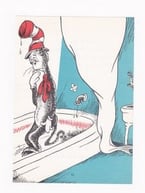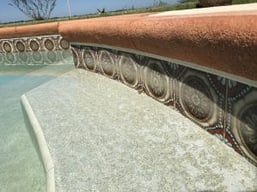ORENDA TECHNOLOGIES
Scum lines are exactly what they sound like: lines of scum that form around the water’s edge, adhering to tile, grout, gunite, and even stainless steel. By scum, we mean carbon-based bather waste (such as body oils, sweat, grease, etc.), as well as body products (like deodorant, perfumes, sunscreen, and lotions). If you are unfamiliar with scum lines, ask any lifeguard. They are often assigned to scrub them off with a brush and cleaning gel, and it takes a good bit of time and labor. Not to mention, a lot of cleaning products.
Even the Cat in the Hat struggled with one in the bathtub.
Once scrubbed off the walls, a typical commercial pool gets a few days of a clean look…before the scum line returns. In reality, the scum adheres almost immediately after scrubbing but takes time to build to the point of needing to be cleaned again. In other words, scum lines are an almost-guaranteed nuisance in a pool or spa. But why?
We can start with the physical properties of this ‘scum’ we refer to. It is primarily carbon-based and oily. And if we remember science class in 3rd grade, we know that oils are lighter than water, and float. Therefore…
Scum floats
Scum combines with dirt in the water, due to the sticky nature of its makeup. Oftentimes, scum is less dense than water—depending on the chemical ingredients—which makes scum float to the top of the pool or spa. In fact, in some cases, carbon waste can emulsify (stay mixed) with the water when the pump is operating, and only floats when the water is over-saturated with it. A good way to detect this condition is to turn off the pump and wait.
After 15 minutes or so, look across the surface of the water. The surface may look dull, or you may even see chunks of scum. If not, turn the underwater lights on.
Chlorine struggles to accomplish complete removal of organic waste, which we at Orenda have discussed in great detail here. This is not to say chlorine cannot do the job in high enough doses, it just takes a lot, and we believe that regular use of natural chemicals like our CV-600 and CV-700 catalytic enzymes is a better, targeted solution.
Scum lines are evidence of overloaded pool water

Scum lines are an indication of overloaded water, where chlorine cannot keep up with the bather waste (oxidant) demand. If you have scum lines, chances are your water also struggles to reach breakpoint chlorination. They are very common in commercial pools and private hot tubs, and should not be ignored. No, scum lines themselves are not what is harmful. They are evidence of a bigger problem: overloaded organic waste and dirt in your water. If chlorine were able to keep up with your organic load, it would be almost impossible for scum lines to occur.
The bigger problem is not what forms scum, but what can be contained in it. Scum, because of its physical characteristics, can hold bacteria and disease in its blend. It’s kind of like how algae can hold ortho-phosphates within their cell walls, protecting them from chlorine. Much of the bacteria is isolated from the sanitizer when that happens; this protects bacteria and disease from chlorine. The same thing can happen in the filter and the pipes.
We at Orenda recommend regular, proper dosing of our CV-600 enzymes to help break down and digest non-living organics. That way, chlorine doesn’t get used up on the organics, and the path is cleared for chlorine to kill germs. Orenda products are natural chemicals that do not kill or oxidize anything, but they do a remarkable job of removing scum lines directly, as well as preventing them from forming. They are all-natural chemicals to help you keep your pool clean and clear.

